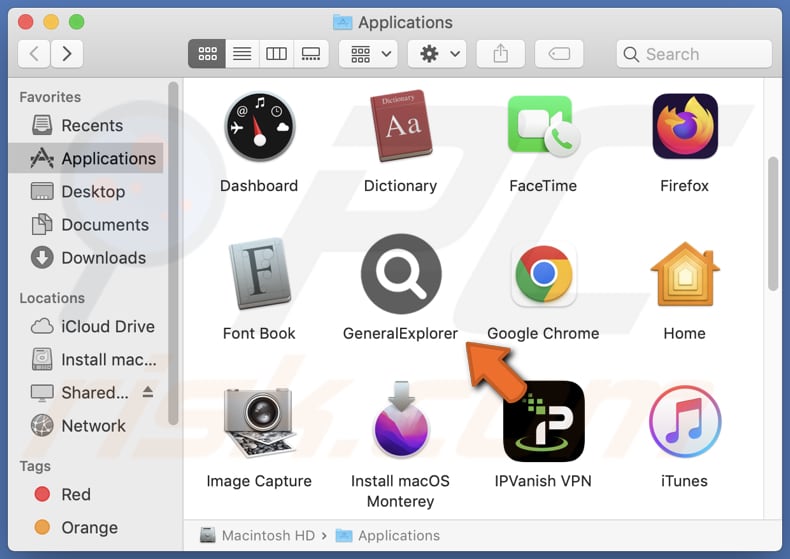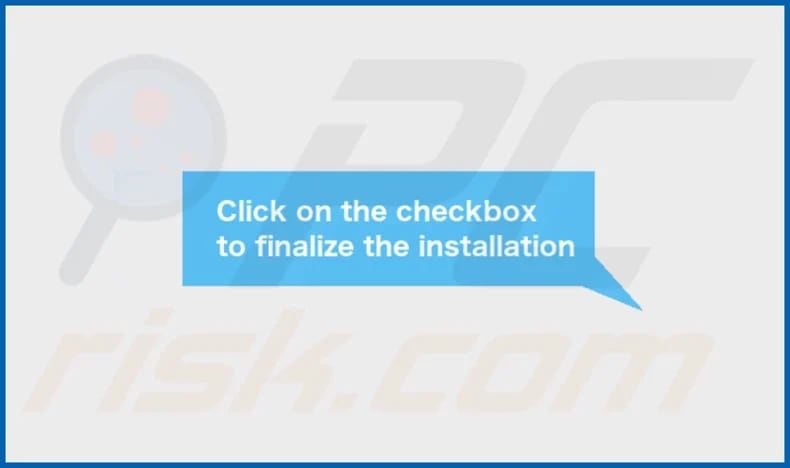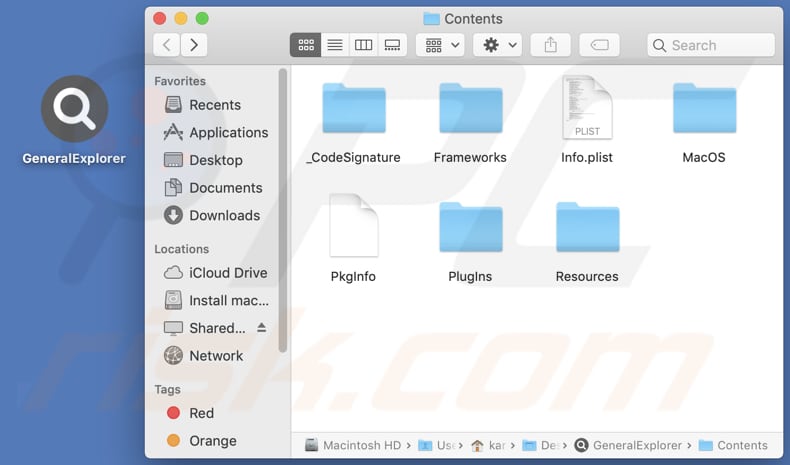How to remove GeneralExplorer from the operating system
![]() Written by Tomas Meskauskas on
Written by Tomas Meskauskas on
What kind of application is GeneralExplorer?
Following an analysis of GeneralExplorer, our team has established that its primary purpose is to deliver intrusive advertisements to users, classifying it as adware. It is important to emphasize that apps akin to GeneralExplorer are often promoted and distributed through deceptive methods.

GeneralExplorer adware in detail
GeneralExplorer is a prime example of adware, a type of software that is primarily designed to display unwanted and often intrusive advertisements to users. The objective of GeneralExplorer is clear: generate revenue for its creators through advertising. While the creators of adware often claim that their goal is to provide users with special offers or discounts, the reality is that these intrusive ads can be annoying, invasive, and sometimes even deceptive.
Apps like GeneralExplorer inundate users with pop-up ads, banners, auto-play videos, and interstitial ads that disrupt the user's browsing experience, making it difficult to focus on content or tasks. Ads displayed by adware can open a variety of web pages, including malicious sites hosting malware, phishing pages, unwanted software downloads, fake system alerts, and more.
Some ads may promote online shopping, surveys, adult content, or gambling websites, while others may lead to tech support scams or phishing attempts. Clicking on ads generated by apps like GeneralExplorer can lead to unwanted consequences, including security risks, privacy breaches, and financial losses.
Certain adware extends its impact beyond displaying ads by altering browser configurations. This includes modifying the homepage and default search engine, essentially taking control of the user's browsing experience without their permission.
Moreover, adware often tracks users' online activities, including visited websites, search queries, and even personal information. This data can be used to create detailed user profiles for targeted advertising, raising significant privacy concerns.
| Name | Ads by GeneralExplorer |
| Threat Type | Adware, Mac malware, Mac virus |
| Detection Names | Avast (MacOS:Adload-AG [Adw]), Combo Cleaner (Gen:Variant.Adware.MAC.AdLoad.13), ESET-NOD32 (A Variant Of OSX/Adware.Synataeb.G), Kaspersky (Not-a-virus:HEUR:AdWare.OSX.Adload.h), Full List (VirusTotal) |
| Additional Information | This application belongs to Adload malware family. |
| Symptoms | Your Mac becomes slower than normal, you see unwanted pop-up ads, you are redirected to dubious websites. |
| Distribution methods | Deceptive pop-up ads, free software installers (bundling), torrent file downloads. |
| Damage | Internet browser tracking (potential privacy issues), display of unwanted ads, redirects to dubious websites, loss of private information. |
| Malware Removal (Mac) | To eliminate possible malware infections, scan your Mac with legitimate antivirus software. Our security researchers recommend using Combo Cleaner. |
Conclusion
Adware is a type of unwanted software that primarily serves to display intrusive and often irrelevant advertisements to users. Adware may also modify browser settings, hijacking the browsing experience, and can pose risks such as privacy invasion, security vulnerabilities, and a decline in overall system performance.
Users are advised to be cautious and employ security measures to avoid adware-related issues. More examples of advertising-supported apps targeting macOS users are EssentialProcesser, FontResultsMultitask, and ExplorerMainFrame.
How did GeneralExplorer install on my computer?
Users often unwittingly install adware when downloading and installing software or applications from untrustworthy sources, especially those offering cracked or pirated versions of popular software. Adware may be bundled with these downloads and installed alongside the desired software.
Additionally, clicking on deceptive ads or links, especially those claiming to provide free software, software updates, or enticing offers, can lead to adware installation. Some users might unknowingly install adware when visiting compromised pages or interacting with downloads from P2P networks, torrent sites, and similar sources.
How to avoid installation of unwanted applications?
Obtain software and apps exclusively from trusted and official sources like official app stores or the developers' websites. Be vigilant when clicking on ads, links, or downloading files, especially from unverified or suspicious websites. Do not allow shady websites to send notifications.
Periodically review and remove unnecessary or suspicious browser extensions that may have been installed without your consent. Employ reputable antivirus or anti-malware software to detect and block adware threats. If your computer is already infected with GeneralExplorer, we recommend running a scan with Combo Cleaner Antivirus for macOS to automatically eliminate this adware.
A message that appears after the installation of GeneralExplorer:

GeneralExplorer's installation folder:

Instant automatic Mac malware removal:
Manual threat removal might be a lengthy and complicated process that requires advanced IT skills. Combo Cleaner is a professional automatic malware removal tool that is recommended to get rid of Mac malware. Download it by clicking the button below:
▼ DOWNLOAD Combo Cleaner for Mac
By downloading any software listed on this website you agree to our Privacy Policy and Terms of Use. To use full-featured product, you have to purchase a license for Combo Cleaner. Limited seven days free trial available. Combo Cleaner is owned and operated by Rcs Lt, the parent company of PCRisk.com read more.
Quick menu:
- What is GeneralExplorer?
- STEP 1. Remove GeneralExplorer related files and folders from OSX.
- STEP 2. Remove GeneralExplorer ads from Safari.
- STEP 3. Remove GeneralExplorer adware from Google Chrome.
- STEP 4. Remove GeneralExplorer ads from Mozilla Firefox.
Video showing how to remove GeneralExplorer adware using Combo Cleaner:
GeneralExplorer adware removal:
Remove GeneralExplorer-related potentially unwanted applications from your "Applications" folder:

Click the Finder icon. In the Finder window, select "Applications". In the applications folder, look for "MPlayerX", "NicePlayer", or other suspicious applications and drag them to the Trash. After removing the potentially unwanted application(s) that cause online ads, scan your Mac for any remaining unwanted components.
Remove adware-related files and folders

Click the Finder icon, from the menu bar. Choose Go, and click Go to Folder...
 Check for adware generated files in the /Library/LaunchAgents/ folder:
Check for adware generated files in the /Library/LaunchAgents/ folder:

In the Go to Folder... bar, type: /Library/LaunchAgents/

In the "LaunchAgents" folder, look for any recently-added suspicious files and move them to the Trash. Examples of files generated by adware - "installmac.AppRemoval.plist", "myppes.download.plist", "mykotlerino.ltvbit.plist", "kuklorest.update.plist", etc. Adware commonly installs several files with the exact same string.
 Check for adware generated files in the ~/Library/Application Support/ folder:
Check for adware generated files in the ~/Library/Application Support/ folder:

In the Go to Folder... bar, type: ~/Library/Application Support/

In the "Application Support" folder, look for any recently-added suspicious folders. For example, "MplayerX" or "NicePlayer", and move these folders to the Trash.
 Check for adware generated files in the ~/Library/LaunchAgents/ folder:
Check for adware generated files in the ~/Library/LaunchAgents/ folder:

In the Go to Folder... bar, type: ~/Library/LaunchAgents/

In the "LaunchAgents" folder, look for any recently-added suspicious files and move them to the Trash. Examples of files generated by adware - "installmac.AppRemoval.plist", "myppes.download.plist", "mykotlerino.ltvbit.plist", "kuklorest.update.plist", etc. Adware commonly installs several files with the exact same string.
 Check for adware generated files in the /Library/LaunchDaemons/ folder:
Check for adware generated files in the /Library/LaunchDaemons/ folder:

In the "Go to Folder..." bar, type: /Library/LaunchDaemons/

In the "LaunchDaemons" folder, look for recently-added suspicious files. For example "com.aoudad.net-preferences.plist", "com.myppes.net-preferences.plist", "com.kuklorest.net-preferences.plist", "com.avickUpd.plist", etc., and move them to the Trash.
 Scan your Mac with Combo Cleaner:
Scan your Mac with Combo Cleaner:
If you have followed all the steps correctly, your Mac should be clean of infections. To ensure your system is not infected, run a scan with Combo Cleaner Antivirus. Download it HERE. After downloading the file, double click combocleaner.dmg installer. In the opened window, drag and drop the Combo Cleaner icon on top of the Applications icon. Now open your launchpad and click on the Combo Cleaner icon. Wait until Combo Cleaner updates its virus definition database and click the "Start Combo Scan" button.

Combo Cleaner will scan your Mac for malware infections. If the antivirus scan displays "no threats found" - this means that you can continue with the removal guide; otherwise, it's recommended to remove any found infections before continuing.

After removing files and folders generated by the adware, continue to remove rogue extensions from your Internet browsers.
Remove malicious extensions from Internet browsers
 Remove malicious Safari extensions:
Remove malicious Safari extensions:

Open the Safari browser, from the menu bar, select "Safari" and click "Preferences...".

In the preferences window, select "Extensions" and look for any recently-installed suspicious extensions. When located, click the "Uninstall" button next to it/them. Note that you can safely uninstall all extensions from your Safari browser - none are crucial for regular browser operation.
- If you continue to have problems with browser redirects and unwanted advertisements - Reset Safari.
 Remove malicious extensions from Google Chrome:
Remove malicious extensions from Google Chrome:

Click the Chrome menu icon ![]() (at the top right corner of Google Chrome), select "More Tools" and click "Extensions". Locate all recently-installed suspicious extensions, select these entries and click "Remove".
(at the top right corner of Google Chrome), select "More Tools" and click "Extensions". Locate all recently-installed suspicious extensions, select these entries and click "Remove".

- If you continue to have problems with browser redirects and unwanted advertisements - Reset Google Chrome.
 Remove malicious extensions from Mozilla Firefox:
Remove malicious extensions from Mozilla Firefox:

Click the Firefox menu ![]() (at the top right corner of the main window) and select "Add-ons and themes". Click "Extensions", in the opened window locate all recently-installed suspicious extensions, click on the three dots and then click "Remove".
(at the top right corner of the main window) and select "Add-ons and themes". Click "Extensions", in the opened window locate all recently-installed suspicious extensions, click on the three dots and then click "Remove".

- If you continue to have problems with browser redirects and unwanted advertisements - Reset Mozilla Firefox.
Frequently Asked Questions (FAQ)
What harm can adware cause?
Adware can disrupt the online experience, making it difficult to focus on content or tasks, pose a significant privacy risk, and consume system resources.
What does adware do?
Adware primarily serves to display intrusive and often irrelevant advertisements to users. Sometimes, software of this type hijacks web browsers and (or) collects various information.
How do adware developers generate revenue?
Developers of adware usually earn income by endorsing a variety of products, websites, or services, with a significant portion of their earnings coming from affiliate programs.
Will Combo Cleaner remove GeneralExplorer adware?
Combo Cleaner will conduct a comprehensive scan of your computer to remove all installed adware-type applications. Manual removal may not always be effective, as some residual files remain concealed within the system even after the software has been uninstalled.


▼ Show Discussion